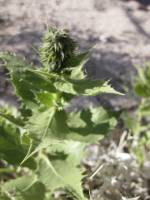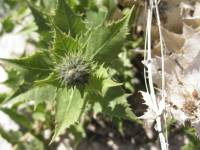- Home
- Search
- Images
- Datasets
- Sample Use
- How to Cite
- Additional Information
- About NEON
- NEON Data Portal
- ASU Biocollections
- About Symbiota
|
|
|
|
Family: Asteraceae
hollyleaf bur ragweed
[Franseria ilicifolia A. Gray] |
Shrubs, 30-50(-120+) cm. Stems erect. Leaves mostly alternate; petioles 0-2 mm; blades (green) elliptic to ovate, 25-60+ × 12-35+ mm, bases rounded to truncate, margins spiny-toothed, abaxial and adaxial faces ± hirtellous (on veins) and stipitate-glandular. Pistillate heads clustered, proximal to staminates; florets 2. Staminate heads: peduncles 2-8(-12) mm; involucres ± saucer-shaped, 9-15+ mm diam., ± hirtellous and stipitate-glandular; florets 20-40+. Burs: bodies ± globose, 6-8 mm, stipitate-glandular, spines 40-50+, scattered, subulate, 4-6 mm, tips straight or ± uncinate. 2n = 36. Flowering Jan-Apr. Sandy washes, benches; 30-500 m; Ariz., Calif.; Mexico (Baja California, Sonora). FNA 2006, Keil 2014 (Jepson) Common Name: hollyleaf bur ragweed Duration: Perennial Nativity: Native Lifeform: Subshrub General: Matted shrubs, 30-50(-120+) cm tall; stems erect, sparsely branched; herbage densely glandular and sticky, and covered with short stiff hairs. Leaves: Mostly alternate and sessile; blades elliptic to ovate, 2-6 cm long by 1-3 cm wide, with rounded to truncate bases, spiny-toothed margins, and hirtellous, stipitate-glandular surfaces. Flowers: Male and female flowers on separate plants; staminate heads arranged in racemes on peduncles 2-8 mm long; staminate involucres saucer-shaped, 9-15 mm in diameter, hirtellous and stipitate-glandular, with 20-40 disc florets; pistillate heads clustered at the bottom of the staminate raceme, each with 2 disc florets. Fruits: Burs globose, the bodies 6-8 mm long, stipitate-glandular, and covered with 40-50 subulate spines, these 4-6 mm long with straight or hooked tips. Ecology: Found in sandy washes, canyons, and creosote-bush scrub, below 2,000 ft (610 m); flowers Jan-Apr. Distribution: AZ and CA; south to n MEX (Baja California, Sonora). Notes: This spiny-leafed Ambrosia is limited to the extreme southwest corner of Arizona and neighboring California and Mexico. Look for a low shrubby perennial with leaves that have spiny teeth on the edges, similar to holly or barberry leaves; the characteristic Ambrosia raceme of pendulous male flower heads, with the heads on this species being noticeably larger than many other Ambrosia; and the cluster of female flowers, turning into burs, at the base of the raceme. Through a hand lens the racemes are noticeably covered with glands and hairs. Ethnobotany: Unknown, but other species in the genus have uses. Etymology: Ambrosia is Greek for food of the gods; ilicifolia means holly-leaf. Synonyms: Franseria ilicifolia Editor: AHazelton 2015 |




